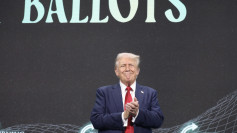President Donald Trump said Friday he had ordered two U.S. nuclear submarines to be moved to "the appropriate regions" in response to what he called "highly provocative statements" from former Russian President Dmitry Medvedev, escalating tensions between Washington and Moscow over the war in Ukraine.
"Based on the highly provocative statements of the Former President of Russia, Dmitry Medvedev ... I have ordered two Nuclear Submarines to be positioned in the appropriate regions, just in case these foolish and inflammatory statements are more than just that," Trump posted on Truth Social.
Trump added: "Words are very important, and can often lead to unintended consequences, I hope this will not be one of those instances." The White House and Pentagon declined to comment, in line with long-standing U.S. policy not to disclose the locations of nuclear-armed submarines.
The move follows a warning from Medvedev, now deputy chairman of Russia's Security Council, who on Thursday referenced Moscow's Soviet-era nuclear capabilities after Trump had publicly warned him to "watch his words." Medvedev has gained a reputation as one of the Kremlin's most aggressive voices since Russia invaded Ukraine in 2022.
Asked about the deployment by reporters, Trump responded: "A threat was made by a former president of Russia, and we're going to protect our people."
U.S. security analysts said Trump's order likely represents political signaling rather than a fundamental shift in military posture. "The subs are always there all the time and don't need to be moved into position," said Hans Kristensen of the Federation of American Scientists. "He grants Medvedev a response to these crazy statements."
The U.S. Navy maintains 14 Ohio-class ballistic missile submarines, each capable of carrying up to 20 Trident II D5 nuclear missiles with ranges exceeding 4,600 miles. These submarines form the sea-based leg of America's nuclear triad, alongside long-range bombers and land-based intercontinental missiles. Between eight and ten are typically deployed at any time, according to the Nuclear Threat Initiative.
Defense experts voiced concern over Trump's language. "This is irresponsible and inadvisable," said Daryl Kimball, executive director of the Arms Control Association. "No leader or deputy leader should be threatening nuclear war, let alone in a juvenile manner on social media."
Trump's move coincides with his growing frustration over what he views as Russian President Vladimir Putin's failure to engage in peace talks. On Tuesday, Trump warned that Russia had "10 days from today" to agree to a ceasefire or face U.S.-imposed tariffs. Putin, speaking Friday, made no mention of the deadline but said Moscow remained open to peace negotiations while asserting that battlefield momentum was in Russia's favor.
Evelyn Farkas, a former Pentagon official and current head of the McCain Institute, dismissed fears of imminent nuclear conflict. "It's really signaling. It's not the beginning of some nuclear confrontation and nobody reads it as such," she said. "And I would imagine the Russians don't either." Still, she noted that such rhetoric was unlikely to alter Russia's course.
Trump, who once touted close ties with Putin, has recently intensified criticism of the Russian leader, accusing him of "bullshit" and calling recent attacks on Ukraine "disgusting." Kristensen warned that Trump's approach could entrap the U.S. in a "commitment trap" that raises public expectations of nuclear retaliation.






